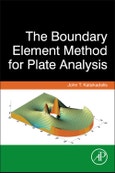Boundary Element Method for Plate Analysis offers one of the first systematic and detailed treatments of the application of BEM to plate analysis and design.
Aiming to fill in the knowledge gaps left by contributed volumes on the topic and increase the accessibility of the extensive journal literature covering BEM applied to plates, author John T. Katsikadelis draws heavily on his pioneering work in the field to provide a complete introduction to theory and application.
Beginning with a chapter of preliminary mathematical background to make the book a self-contained resource, Katsikadelis moves on to cover the application of BEM to basic thin plate problems and more advanced problems. Each chapter contains several examples described in detail and closes with problems to solve. Presenting the BEM as an efficient computational method for practical plate analysis and design, Boundary Element Method for Plate Analysis is a valuable reference for researchers, students and engineers working with BEM and plate challenges within mechanical, civil, aerospace and marine engineering.
Table of Contents
Preface
1) Preliminary mathematical knowledge
2) Plate bending analysis with the BEM
3) The BEM for other plate problems
4) The BEM for dynamic analysis of plates
5) The BEM for large deflection analysis of elastic membranes
Appendices
References








